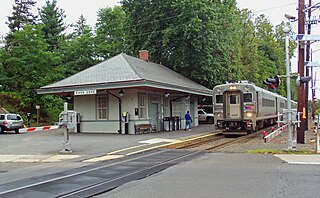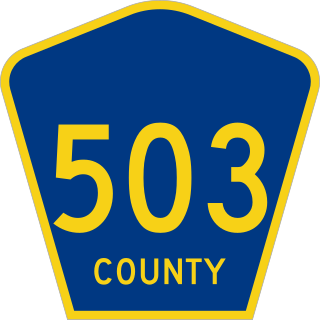The Erie Railroad was a railroad that operated in the Northeastern United States, originally connecting Pavonia Terminal in Jersey City, New Jersey, with Lake Erie at Dunkirk, New York. The railroad expanded west to Chicago following its 1865 merger with the former Atlantic and Great Western Railroad, also known as the New York, Pennsylvania and Ohio Railroad. Its mainline route proved influential in the development and economic growth of the Southern Tier of New York state, including the cities of Binghamton, Elmira, and Hornell. The Erie Railroad repair shops were located in Hornell and was Hornell's largest employer. Hornell was also where Erie's mainline split into two routes with one proceeding northwest to Buffalo and the other west to Chicago.

The Delaware, Lackawanna and Western Railroad was a U.S. Class 1 railroad that connected Buffalo, New York, and Hoboken, New Jersey, a distance of 395 miles (636 km). Incorporated in Pennsylvania in 1853 primarily for the purpose of providing a connection between the anthracite coal fields of Pennsylvania's Coal Region and the large markets for coal in New York City. The railroad gradually expanded both East and West, eventually linking Buffalo with New York City.

The Erie Lackawanna Railway, known as the Erie Lackawanna Railroad until 1968, was formed from the 1960 merger of the Erie Railroad and the Delaware, Lackawanna & Western Railroad. The official motto of the line was "The Friendly Service Route".

The New York, Susquehanna and Western Railway is a Class II American freight railway operating over 400 miles (645 km) of track in the northeastern U.S. states of New York, Pennsylvania, and New Jersey.

The Pascack Valley Line is a commuter rail line operated by the Hoboken Division of New Jersey Transit, in the U.S. states of New Jersey and New York. The line runs north from Hoboken Terminal, through Hudson and Bergen counties in New Jersey, and into Rockland County, New York, terminating at Spring Valley. Service within New York is operated under contract with Metro-North Railroad. The line is named for the Pascack Valley region that it passes through in northern Bergen County. The line parallels the Pascack Brook for some distance. The line is colored purple on system maps, and its symbol is a pine tree.

The Main Line is a commuter rail line owned and operated by New Jersey Transit running from Suffern, New York to Hoboken, New Jersey, in the United States. It runs daily commuter service and was once the north–south main line of the Erie Railroad. It is colored yellow on NJ Transit system maps, and its symbol is a water wheel.

NJ Transit Rail Operations is the rail division of NJ Transit. It operates commuter rail service in New Jersey, with most service centered on transportation to and from New York City, Hoboken, and Newark. NJ Transit also operates rail service in Orange and Rockland counties in New York under contract to Metro-North Railroad. The commuter rail lines saw 45,838,200 riders in 2022, making it the third-busiest commuter railroad in North America and the longest commuter rail system in North America by route length.

The Bergen County Line is a commuter rail line and service owned and operated by New Jersey Transit in the U.S. state of New Jersey. The line loops off the Main Line between the Meadowlands and Glen Rock, with trains continuing in either direction along the Main Line. It is colored on NJT system maps in grey, and its symbol is a cattail, which are commonly found in the Meadowlands where the line runs.

The Northern Branch is a railroad line that runs from Jersey City to Northvale in northeastern New Jersey, and formerly extended further into New York State. The line was constructed in 1859 by the Northern Railroad of New Jersey to connect the New York and Erie Railroad's Piermont Branch terminus in Piermont, New York, directly to Erie's primary terminal in Jersey City, initially Exchange Place, later Pavonia Terminal. In 1870 the line was extended to Nyack, New York, and continued to provide passenger service until 1966. After the Erie's unsuccessful merger with the Lackawanna Railroad to form the Erie-Lackawanna, ownership of the line passed into the hands of Conrail upon its formation in 1976 from a number of bankrupt railroads.

New Bridge Landing, signed as New Bridge Landing at River Edge, is an active commuter railroad station in the borough of River Edge, Bergen County, New Jersey. Located at the junction of Kinderkamack Road and Grand Avenue and next to Route 4, the station is serviced by Pascack Valley Line trains running between Hoboken Terminal in Hoboken and Spring Valley station in the eponymous village in Rockland County, New York. The next station to the north is the eponymous River Edge and the next station to the south is Anderson Street in Hackensack. The station contains a single low-level side platform on the southbound side of the track, resulting in the station not being accessible for handicapped persons per the Americans with Disabilities Act of 1990.

Westwood is an NJ Transit railroad station in Westwood, New Jersey. It is on the Pascack Valley Line and is located at Broadway and Westwood Avenue. The next station northbound, heading toward Spring Valley, New York, is Hillsdale. The next station southbound, headed for Hoboken Terminal, is Emerson. The station consists of one track, one low-level platform with a miniature high-level platform and a station depot maintained by the borough of Westwood. Westwood also maintains the parking lots, consisting of 226 parking spaces, six of which are accessible based on the Americans With Disabilities Act of 1990.

Woodcliff Lake is an active commuter railroad station in the borough of Woodcliff Lake, Bergen County, New Jersey. Located at the junction of Woodcliff Avenue and Broadway on the edge of the Woodcliff Lake Reservoir, the station is served by trains of New Jersey Transit's Pascack Valley Line. The station, which contains a single track and low-level side platform, is not accessible per handicapped persons under the Americans with Disabilities Act of 1990. As of November 8, 2020, Woodcliff Lake is serviced seven days a week by New Jersey Transit trains, having previously only been a single train on weekends and holidays up to that point.

County Route 503 is a county highway in the U.S. state of New Jersey. The highway extends 17.95 miles from Paterson Plank Road in East Rutherford to the New York state line at the Montvale NJ/Pearl River NY border, where it continues as New York State Route 304. It parallels the Hackensack River and New Jersey Transit's Pascack Valley Line for much of its route.

The New York and Greenwood Lake Railway owned a line between Croxton, Jersey City, New Jersey and Greenwood Lake, New York. Service on the line was provided by the Erie Railroad.

Anderson Street is a New Jersey Transit rail station on the Pascack Valley Line. The station is one of two rail stations in Hackensack and located at Anderson Street near Linden Street.

The Hackensack and New York Railroad was a New Jersey railroad company which was chartered in 1856. The railway ran from Rutherford, New Jersey to Hackensack, New Jersey and service started in 1858. Construction along a northward extension of the line known as the Hackensack and New York Extension Railroad under the leadership of David P. Patterson started in 1866. Service to Hillsdale opened on March 4, 1870.

Fairmount Avenue is a former New Jersey Transit rail station on the Pascack Valley Line. The station was one of three rail stations in Hackensack, New Jersey, and was located at Fairmount Avenue and Temple Avenue. The Essex Street and Anderson Street stations are also located in Hackensack. The station house was built in 1870 as part of the extension railroad for the Hackensack and New York Railroad on a track extension from Anderson Street in Hackensack. The line became part of the Erie Railroad in 1896 and New Jersey Transit in 1983.

Essex Street, known as Hackensack during the Erie Railroad era, is a New Jersey Transit rail station on the Pascack Valley Line, located in Hackensack, New Jersey, at 160 John Street. The Pascack Valley Line services this station seven days a week.

WR Draw is an out-of-service railroad bridge crossing the Passaic River between Newark and the Arlington section of Kearny, New Jersey. The plate girder rim-bearing swing bridge, originally built in 1897 and modified in 1911 and 1950, is the 14th bridge from the river's mouth at Newark Bay and is 8.1 miles (13.0 km) upstream from it. Last used for regular passenger service in 2002, it is welded in closed position as its height is not considered a hazard to navigation.























